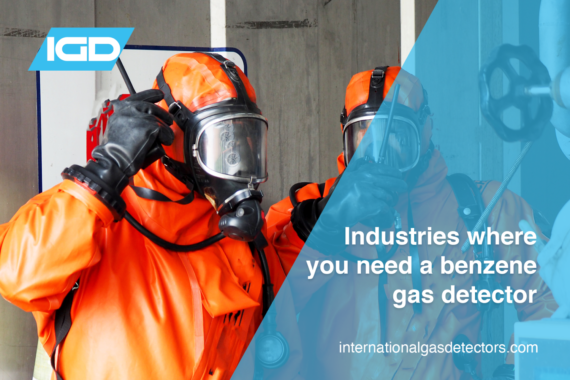Cleanrooms are found across a wide range of industries for a vast range of uses. This includes the most common ones such as laboratories, pharmaceutical and medical as well as semi-conductor applications and many other less common ones. Each of these industries need to monitor VOCs for a wide range of reasons, from the hazards they may cause to the personnel to the effects on the work they are doing, thus a fixed VOC monitor will be needed in each of these applications. This article will detail the reasons why a Fixed VOC Monitor may be required in each application as well as the hazards that come with VOCs. This article will also detail the revolutionary Fixed VOC Monitors on offer from IGD. Read on below to find out more.
Industries where you need a Benzene Gas Detector
Benzene gas can be found in a wide range of applications, mostly being environmentally related such as petroleum and process industries. Benzene is a liquid at room temperature but quickly turns vaporous in the atmosphere, meaning this can be highly prevalent in these industries. . This article will delve into where benzene gas is found, the dangers associated with this substance and IGDs detectably better Benzene Gas Detector solutions to help mitigate the risks of this gas.
Implementing a Nitrous Oxide Monitor for Pollution Mitigation
The recent COP 26 summit in Glasgow made a large amount of promises in regard to pollution management. One of the main focuses of this summit was the mitigation of climate change, including the reduction of N2O gas emissions. Implementing a nitrous oxide monitors is proven to be the most effective way to reduce your N2O emissions, but why do I need to do this? And what is the most suitable, detectably better device for my application? Read on below for the best advice from our team of experts.
Maintaining Cleanroom Safety with Sampling Gas Detectors
Cleanrooms are enclosed facilities specially designed to control levels of airborne contamination. Depending on the particle concentration (per m3), clean rooms are categorized into nine ISO classes. Class 1 being the purest and containing only 12 particles per cubic meter. By contrast, the particulate concentration of ambient air is around 35 million particles per cubic meter. Sampling gas detectors are used to monitor for safety cleanroom environments in scientific research and manufacturing industries.
Read our article to learn more.
Gas Detection Solutions for Cold Room Applications
Cold room units (or walk-in freezers) are an integral part of the food and beverage processing industries. Typical refrigerant gases include carbon dioxide, ammonia, and hydrocarbons such as propane, isobutane and propylene. Older cold storage solutions still use freon gases such as R134a. Thus, a versatile range of gas detection solutions are required for cold storage applications.
Read our article to learn more.
Using Formaldehyde Gas Detectors in Medical Labs
Formaldehyde (CH2O) is a fairly simple chemical compound that is naturally produced in low volumes through regular cellular metabolism. It is best known for its profound anti-bacterial characteristics hence its long-standing application as one of the main preservatives used in mortuaries. However, formaldehyde solutions—where the gas is mixed with an aqueous mobile phase—are extremely valuable to a wide range of medical research areas. They are routinely used to deactivate viruses for vaccine manufacturing, for instance.
Our article discusses the toxic hazards of formaldehyde and our formaldehyde gas detector solutions.
Oxygen Detectors: What is an O2 Depletion Monitor?
Oxygen (O2) depletion monitors are devices capable of measuring the ambient concentration of atmospheric oxygen and signalling when Ievels have fallen. This can enable action to be taken before an evacuation is required and levels become dangerous. In addition to oxygen depletion, problems arise when oxygen levels are too high. This oxygen “enrichment” (levels above 23%) can be dangerous; increasing the chances of combustion and the intensity of fires. In summary, oxygen detectors can signal all dangerous levels of oxygen and are important instruments for a range of applications.







